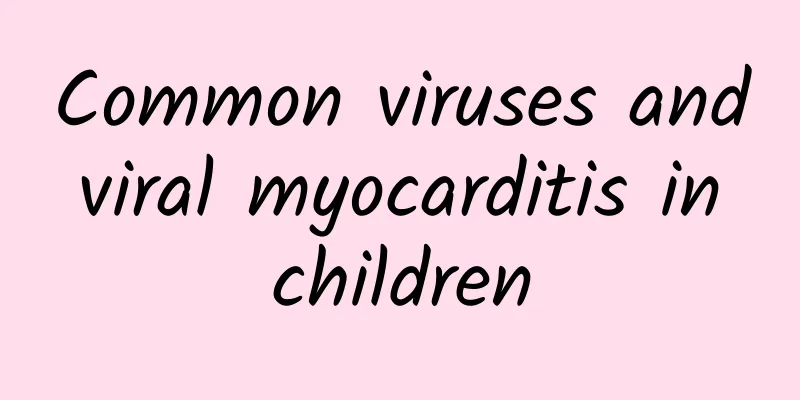Common viruses and viral myocarditis in children

|
Children's colds are not trivial matters, especially the recent spread of various respiratory viruses, led by influenza A virus, has greatly increased the incidence of viral myocarditis in children. Next, we will introduce the causes and symptoms of this common disease, viral myocarditis, as well as some simple common sense in clinical treatment. 1. Causes: Viral myocarditis is an acute or chronic inflammation caused by various viruses, especially coxsackievirus, which is the most common and accounts for more than half of viral myocarditis. Others include influenza A virus, echovirus, poliovirus, hepatitis virus, adenovirus, respiratory syncytial virus, mumps virus, varicella virus, herpes virus, Epstein-Barr virus, cytomegalovirus[1], chikungunya virus, etc. 2. Pathogenesis: In the early stage of viral infection, the virus directly invades myocardial cells, leading to an acute inflammatory response. Myocardial necrosis, degeneration and cell infiltration occur. Subsequently, specific cytotoxic T lymphocytes cause myocardial lysis, resulting in severe myocardial damage. 3. Clinical manifestations: The severity of myocarditis varies greatly. Mild cases may even have no clinical symptoms. Severe cases can lead to fulminant cardiogenic shock, acute congestive heart failure, or severe arrhythmia. Death within a few hours or days. Even sudden death. It is a disease that seriously endangers the life and health of children. It is also one of the most common causes of medical disputes. 1. Symptoms: Respiratory or digestive tract infection within two weeks before the onset of cardiac symptoms. Fever, sore throat, abdominal pain, diarrhea, rash, etc. Subsequently, symptoms of myocarditis appear, including fatigue, nausea, vomiting, loss of appetite, dyspnea, pale complexion, and fever. Older children may complain of palpitations, precordial discomfort, dizziness, abdominal pain, and myalgia. Auscultation reveals dull heart sounds, gallop rhythm[1], accelerated or slow heartbeats, and premature beats. The heart is enlarged and blood pressure is low. 2. Disease severity The disease is divided into three types: mild, moderate and severe. Mild symptoms include fatigue, poor spirits and decreased appetite. Low and dull heart sounds, temporary ST-T changes, tachycardia and cardiac enlargement. The disease can be cured after a few weeks of treatment. Moderate symptoms include vomiting, refusal to eat, pale complexion, dyspnea and dry cough. Older children may complain of precordial pain, dizziness, palpitations, abdominal pain, orthopnea, irritability and cyanosis. Low and dull heart sounds, irregular heart rhythm, cardiac enlargement and heart failure. Lung rales, liver enlargement and tenderness. The course of the disease may last for several months or even years, and may even lead to death from heart failure. Severe cases may lead to serious arrhythmias such as ventricular fibrillation, ventricular tachycardia and complete conduction block. Fulminant cardiogenic shock and sudden death [1]. Symptoms include irritability, dyspnea, pale complexion, cold and clammy skin, sweating, weak pulse, significantly decreased blood pressure, tachycardia and gallop rhythm. Death occurs within a few days or even hours. Survivors may also be left with chronic heart failure, cardiac enlargement, cardiomyopathy, etc., and eventually die of uncontrolled heart failure or embolism. 3. Neonatal Coxsackie B virus myocarditis is mostly transmitted by the mother. The condition is serious and can spread in the neonatal ward, causing great harm. The onset is sudden, with symptoms of fever, anorexia, vomiting, diarrhea, lethargy, dyspnea, and tachycardia. Heart failure and death may occur quickly. IV. Auxiliary examination methods: X-ray may show cardiac enlargement, weakened heartbeat, pulmonary edema, and pleural effusion. Electrocardiogram shows ST-T changes, atrioventricular and intraventricular conduction block, various premature beats, and severe ventricular fibrillation. Chronic cases have left ventricular hypertrophy. Echocardiography can show left ventricular enlargement, decreased amplitude of ventricular septum and left ventricular posterior wall motion. Radionuclide 99mTc examination indicates myocardial ischemia [1]. Cardiac magnetic resonance imaging shows intracellular and interstitial congestion and edema, myocardial necrosis, and calcification. Blood GOT, CK, CK-MB, and LDH can all be elevated in the acute phase. 5. Diagnostic criteria: The diagnosis of viral myocarditis is very strict and needs to meet the corresponding standards. 1. Clinical diagnosis basis (1) Heart failure, cardiogenic shock or cardio-cerebral syndrome. (2) Enlarged heart. (3) Severe arrhythmias, such as persistent ST-T changes, sinoatrial and atrioventricular conduction block, coupled, multi-source, and paired premature contractions. (4) CK-MB, cTnI or cTnT are positive. 2. Etiological diagnosis basis: isolation of virus, viral nucleic acid, and positive specific viral antibodies. Two clinical diagnostic bases plus one etiological diagnosis basis are required to confirm viral myocarditis. 6. Treatment: There is no specific treatment method, and comprehensive treatment measures are usually adopted. 1. Bed rest. Patients with heart enlargement and heart failure should rest in bed for 3-6 months. 2. For patients with restlessness or chest pain, give sedation and analgesia. 3. Immunosuppressants, corticosteroids and azathioprine. Their efficacy is controversial. 4. Immunoglobulin. It has a certain effect on acute severe viral myocarditis in children. 5. Symptomatic treatment: Provide appropriate treatment for arrhythmia, heart failure, and shock. 7. Prognosis: The prognosis of viral myocarditis varies greatly. Some patients can recover after a few months of treatment. Those who have an outbreak may die of shock or heart failure. Some patients may have a protracted illness, leaving behind varying degrees of left ventricular dysfunction, and a few may transition to dilated cardiomyopathy. References: [1] Manual of Prevention and Treatment of Pediatric Critical Illnesses - Part 6 Sun Xuding, Zhuo Lin - Ningxia People's Publishing House - 2007-09-01 Contributor: Chongqing Science Writers Association Writer: Zeng Zhaocheng, deputy chief physician of Chongqing Yongchuan District Children's Hospital; Zou Jingbo, chief technician of Zou Science Garden Review expert: Li Hanbin Statement: Except for original content and special instructions, some pictures are sourced from the Internet for non-commercial purposes and are only used as popular science materials. The copyright belongs to the original author. If there is any infringement, please contact us to delete it. |
<<: Don’t let “popularity” hurt your “heart”
>>: Be alert to severe allergic reactions around you: health alerts that may affect your life
Recommend
What are the symptoms of women's stomach problems?
Some female friends nowadays are the backbones in...
CIC: China's social media landscape in 2016 (with historical charts)
Kantar Media CIC officially released the "20...
If I have onychomycosis, do I need to remove the nail to treat it?
Not really Onychomycosis is the common name for o...
Brown discharge from the bottom
The appearance of brown discharge in women should...
What are the benefits of royal jelly for women?
Royal jelly is a health product that is very popu...
National Malaria Day丨From 30 million cases to 0 cases, what did it take?
April 26th is the 15th National Malaria Day. Spea...
Women always feel like they can't finish urinating
Being unable to urinate or not urinating complete...
Will my period affect the urine test?
Under normal circumstances, urine testing in clin...
Why can't morning urine detect ovulation?
Ovulation is a very special period. Many women ha...
Onavo: Twitter is only 60% of Instagram on the US iPhone platform
Twitter is only 60% of Instagram on the iPhone in ...
Diet management – tempting snacks
This is the 2736th article of Da Yi Xiao Hu Weigh...
Is jelly orange an orange or a tangerine? How to choose jelly orange
Jelly orange is a kind of dessert. The fruit is r...
Is it normal to bleed for 1 day after an abortion?
After an abortion, doctors usually recommend that...
More time spent on mobile phone per week linked to higher risk of kidney disease
Whether frequent mobile phone use has an impact o...
What to do if you need emergency contraception when you are over 45?
In a relationship between men and women, married ...









